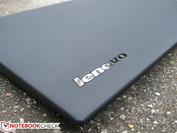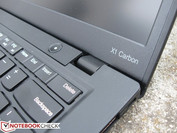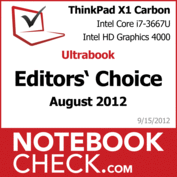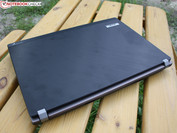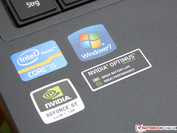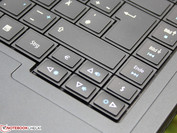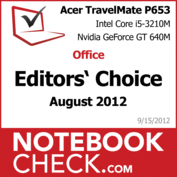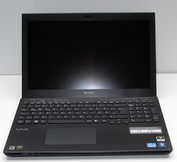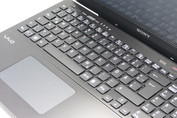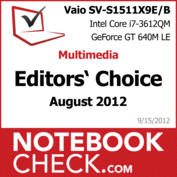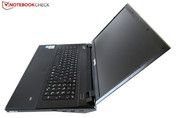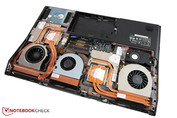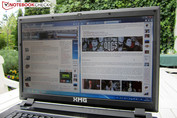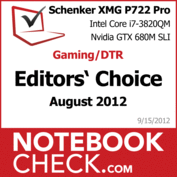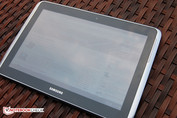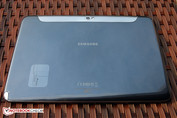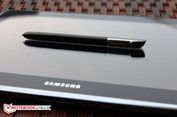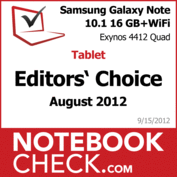Notebookcheck's Best of August 2012
Has Christmas come early? It sure looks like it, since 36 notebook and tablet reviews passed our hands in August. In addition, we saw the Samsung Galaxy beam (GT-I8530) smartphone with integrated projector. Phone calls only possible in range of a power socket? Our review has the answer.
Tablets are evolving fast; Samsung's Galaxy Note 10.1 showed that Nvidia's Tegra 3 will not have the final word when it comes to performance. In the Ultrabook segment, the Lenovo ThinkPad X1 Carbon by our US editor raised some eyebrows. Just 1300 grams (14-inch) and still a robust case? We could hardly believe our eyes.
In August, the low-cost sector did not only see cheap but powerful office notebooks, like Acer's TravelMate P653 (GT 640M). Low-voltage is now also taking hold of budget 11.6-inch models, with Acer's Aspire One 756 (Pentium 987) being the cheapest, and the TravelMate B113-M (Core i3-2377M) the most practical option.
A whopping 12 multimedia devices passed through our hands. Surprise: a strong configuration on paper, with Radeon HD 7670M and Intel Core i7-3612QM performed worse (HP Pavilion g7-2007sg) than an Ultrabook with GeForce GT 630M and Core i7-3517U (Dell XPS 14). Gamers won't even think about these "low-FPS-devices", of course. Instead, Nvidia's GeForce GTX 680M SLI inside the Schenker XMG P722 PRO showed who's boss in the world of mobile gaming.
Subnotebook Category
Contenders:
Toshiba Satellite L830-10F 82%
There are plenty of Ultrabooks in the market today, but few are really suitable for work. Most of them suffer from weak displays, and keyboards with poor feedback. Lenovo now offers an alternative alongside its Ideapad consumer Ultrabook: the ThinkPad X1 Carbon is a real workhorse, fulfilling all the criteria for business use, apart from a docking port.
Another workhorse, but one of the more traditional kind, is the Fujitsu LifeBook P772 (12-inch). The WXGA resolution (1280x800) of the screen is almost reminiscent of the classic 4:3 format.
The connectivity is enormous, besides USB 3.0, ExpressCard54 and DisplayPort there's even a matching docking station included in the box. Those who cannot afford the 1600 Euros (~$2067) price tag, but are interested in a sleek design, might be swayed by Toshiba's Satellite L830-10F. The 13.3-inch model with its modest Core i3 processor offers a good battery life, but the display and input devices are no great pleasure.
Perhaps Dell's consumer Ultrabook Inspiron 14z-5423 shows better office capabilities? Well, that's not the case, but its AMD Radeon HD 7570M is good enough for gaming. Sadly, on the low-contrast glare type panel that's not as much fun as we had hoped. At least, the fast Samsung SSD 830 (128 GB) is a highlight, and together with the Core i5 it delivers a silent and super-fast user experience.
The second business Ultrabook in August was provided by Fujitsu. The LifeBook U772 packs a 14-inch display into a 13.3-inch form factor, thanks to a narrow bezel. The Micron RealSSD C400 and the Core i5 make for a very fast workflow, and five hours of battery life is nothing to be ashamed of. Unfortunately, the input devices provide a weak feedback, the resolution is too low for this price range, and the panel is too dark for outdoor use.
Will Fujitsu's consumer Ultrabook, the 13.3-inch LifeBook UH572, be more convincing? Not according to our rating, but at least it costs only 800 (~$1033) instead of 1200 Euros (~$1550) (LifeBook U772). Once again, the matte display belongs into the low-contrast category. The combination of a conventional 500 GB hard drive and 32 GB of SSD cache still equates to a very good performance. Workmanship is decent, but sadly the input devices are shaky once again.
If you want cheap, then why not go all the way. Acer's Aspire One 756 is available with a low-voltage Pentium for under 400 Euros (~$516). The 11.6-inch specimen neither features perfect build quality nor great input devices. On the upside though, its performance far exceeds that of the AMD Vision competitors in the same price bracket. Due to the weak battery, the same cannot be said for the battery life, which is pretty short at just three hours.
Acer's Travelmate B113-M in the same form factor does not have a longer battery life compared to the Aspire One 756, but it does include a matte screen, a better keyboard, and a Core i3 with greater performance. Unfortunately, stability and display brightness are just as poor as they are on the consumer variant.
Subnotebook of the month of August 2012: Lenovo ThinkPad X1 Carbon
Lenovo demonstrates how impressive an Ultrabook can look. Strong performance without throttling and without high emissions. Combine this with a display which is not just matte and high-resolution, but which also boasts high contrasts, and you have a winner.
What we like
The carbon fiber build leaves a fresh impression with largely the same structural benefits as magnesium alloy materials. The light weight, screen improvements, low system noise, great outdoor usability, and fast application performance are the best qualities of the X1 Carbon.
What we'd like to see
Lenovo has removed a number of features from the original X1 models in order to achieve such a low weight. These include three ports, Gorilla Glass protection, and removable RAM. A larger battery would help tremendously in becoming a more viable all-day outdoor notebook.
What surprises us
The low fan noise given the fast CPU is a double-edged sword. Surface temperatures can get quite warm, but the notebook is hardly audible when in use.
The competition
The Fujitsu Lifebook U772 is perhaps the closest competitor to the X1 Carbon in terms of specs (14-inch display) and size (1.4 kg).
Office Category
Contenders:
HP 655 B6M65EA 76%
Business by Acer? If you think that cannot be a winning combination, you haven't met the TravelMate P653-MG yet. The 15.6-inch model complements the 14-inch sibling P643-MG, which also featured a docking port, many connectors, a high quality and stable build, and decent input devices. Sadly, both models only include low-contrast HD screens. Acer does not offer alternative display options.
As an entry-level ThinkPad, the Edge S430 combines good multimedia performance (GeForce GT 620M), a very good keyboard, and a low noise level in the popular 14-inch form factor. The matte, high resolution (1600x900 pixels) and sufficiently bright display ticks all the boxes that the TravelMate P653-MG did not. On the downside, the ThinkPad gets very hot, and the GPU throttles under load.
If under four hours of runtime are not enough, why not consider a ThinkPad Edge E535 for less money (under 600 Euros (~$775)) but with almost five hours? That's possible thanks to the AMD A8-4500M APU, which achieves a respectable applications performance, in combination with the Radeon HD 7640G. Our HD-Display, for which an HD+ option is also available, can score points with its high brightness, and the input devices don't lag behind those of the Edge S430 by much.
A portable office device with a slim silhouette and aluminum display lid - that's what the Fujitsu LifeBook AH552/SL would like to be. The entry-level hardware, Core i5, HDD and low-contrast HD panel seems a bit too expensive at 600 Euros (~$775). On the other hand, the noise level is low, upgrades are made easy, and the four hour battery life is adequate.
If you're on a tight budget, Lenovo's IdeaPad G580 (Pentium), HP's 655 series and Samsung's RV515-S03DE come into focus. For 300 (~$387) to just under 400 Euros (~$516), none of them are performance wonders, and their HD displays are all of a similar modest quality, with the HP 655's very low brightness being an exception. The IdeaPad G580 is pleasantly quiet, and features a good keyboard as well as USB 3.0. The Samsung RV515-S03DE is extremely quiet and cool (silent mode), and its touch pad provides strong feedback. The HP 655 runs for almost 5:30 hours in Wi-Fi mode while staying cool and quiet. However, with its AMD E2-1800, it's also the weakest in terms of performance.
Like the TravelMates P653/P643, Dell's Vostro 3460 aims to spice up office life with a dedicated graphics card. The GeForce GT 630M brings decent midrange gaming power to the low-luminosity 1366x768 pixel screen. If it wasn't for the poor brightness, the user could make good use of the four hours of battery life. A highlight: four USB 3.0 ports.
Office notebook of the month of August 2012: Acer TravelMate P653-MG
Credit where credit is due. Acer's TravelMate manages to beat not one but two Lenovo ThinkPads when it comes to the final verdict. Granted, as members of the Edge series, these aren't part of the real ThinkPad elite, but the everyday characteristics of the TravelMate are surprisingly good, and the connectivity does not have to dodge the ThinkPad L/Edge series competition either. The weak but matte screen would be alright, if Acer also offered a higher-class alternative for more demanding customers. Sadly, that's not the case.
What we liked
The nice quality of the surfaces, and those of the quality input devices. The solid build quality of the whole case where everything is very well constructed.
What we'd like to see
A higher resolution display would be beneficial for the 15.6-inch TravelMate. As is so often the case, the laptop cannot be utilized outdoors. An improvement in the noise level generated when stressing the GPU. The aluminum surfaces are also very sensitive to fingerprints and light scratches.
What surprises us
What is really surprising is that the Acer has become a very good value-for-money package despite it not having any really outstanding aspects. It is able to provide everything we would have hoped for, with the exception of the speaker quality and display resolution.
The competition
Dell's Vostro 3560, Acer's TravelMate P643, Lenovo's Thinkpad L530, and HP's Probook 6560b will be the main competitors, each with its own advantages and disadvantages (see reviews).
Multimedia Category
Contenders:
HP Envy 6-1000sg 82%
Toshiba Satellite P875-30E 82%
Toshiba Satellite P855-107 80%
Samsung 535U4C 79%
Packard Bell EasyNote TK85-JN-105GE 76%
Packed with a Core i7-3612QM, GeForce GT 640M LE, bright Full HD panel and the fast Samsung SSD, the thin Vaio SV-S1511X9E/B (15.5-inch) brings a lot of powerful hardware to the table. Of course, it comes at a price, 1600 Euros (~$2067) to be precise. No doubt that the highlight is the IPS-Display with its very good viewing angles and good contrast. The fact that it does not cover sRGB will disappoint some professional users.
If you can spend that much money, Dell can offer you a suitable alternative to the Vaio: the Dell XPS 14 Ultrabook is not quite as light as the Vaio, but the Core i7-3517U, GeForce GT 630M, Samsung's SSD 830 and a super bright 1600x-900 pixel display are clearly also targeted at premium customers. Sadly, the 400 cd/m² but glossy display is let down by its black value, which results in a contrast that's far too low for this price bracket. On the upside, both input devices and workmanship are outstanding.
That's all a bit too expensive? Performance for less money but in a heavier and less stylish package is on offer in the form of Lenovo's IdeaPad Y580. With its GeForce GTX 660M, Core i7 3610QM and 1000 GB of storage, the 15.6-inch notebook has turned out to be a real gamer. The 1100 Euros (~$1421) price tag makes it more palatable for the masses. The HD resolution of our test sample offered a good brightness and useful contrast level. There's also an optional Full-HD configuration for an extra charge.
Are you missing stylish, thin devices with a lot of graphics power among the Ultrabook lineup? HP may have the answer with the Envy 6-1000sg. Radeon HD 7670M and Core i5-3317U make the 15.6-inch notebook capable for games. Unfortunately, the GPU is throttled when running on battery, and the glossy screen has turned out too dark. That's a shame, given that the long battery life and good build quality could have turned the laptop into a bestseller, at just 750 Euros (~$969).
You think that Ultrabooks are too fragile? Toshiba delivers something sturdier with the 17-inch Satellite P875-30E (P870-30E). Quad-core and GeForce GT 630M don't quite muster enough gaming power as the 1600x900 pixels would require. Sadly, the contrast and brightness don't fit the 1200 Euros (~$1550) price. On a more positive note, there are two HDD bays, which are fitted with a fast SSD and a 750 GB hard drive, as well as four RAM sockets.
A 17-inch display? We can do that too - that's what Sony seems to want to say with the Vaio SV-E1711X1EB. The price of under 1000 Euros (~$1292) sounds reasonable, given the Radeon HD 7650M and Core i7-3612QM specification. The all-important display hurdle is cleared thanks to a Full-HD-Panel with high contrast, good brightness, matte surface, large viewing angles and (almost) sRGB color space. An insider's tip? Certainly in terms of the screen, but there are also drawbacks such as the high thermal emission and a gaming performance that's inadequate for Full HD.
Acer knows that buyers want attractive gaming hardware at bargain prices. The Aspire V3-571G with GeForce GT 640M and Core i7-3610QM fulfils these criteria. The performance in games is more than enough for the HD resolution, and even with the HDD, applications performance is pretty good for 800 Euros (~$1033), thanks to the quad-core CPU. The low-contrast display with narrow viewing angles seems to be a persistent disease that has infected Acer (and other manufacturers alike).
For about 700 Euros (~$904), Lenovo stocks the shelves with the 15.6-inch IdeaPad Z580. The GeForce GT 630M and Core i5-3210M are responsible for a good gaming performance. Buyers can pick their favorite configuration among a large number of models, but sadly they have no other choice than the bog-standard panel.
A well-known configuration with the GeForce GT 640M and Core i7-3610QM in 15.6-inch format, but this time in a different device: Toshiba's Satellite P855-107. Contrary to the Aspire V3-571G, this one comes equipped with a high-contrast, bright Full-HD display. The fact that it isn't an IPS panel, but a rather good TN panel makes for quite restricted viewing angles. We like the good build quality, as well as the concept of 3D without extra glasses. The downsides are a short battery life, and a slow hard disk.
Dual graphics on a shoestring? That sounds familiar, courtesy of AMD. Samsung uses the Radeon HD 7550M together with the A-Series A6-4455M (Trinity) in its 5 Series 535U4C. The compact 14-inch laptop performs well in terms of materials, workmanship and the matte, very bright screen. Unfortunately, AMD's graphics switching is still uncomfortable, and the performances of the CPU and GPU leaves much to desire.
Packard Bell leaves the beaten track with its EasyNote TK85-JN-105GE and relies on the two year old Sandy-Bridge-1.0 technology. Still, the Core i3-380M is sufficient for simple office or multimedia tasks. Gamers should avoid the GeForce 610M, the dedicated GPU isn't noticeably faster than the HD 4000 integrated into the Ivy-Bridge processor generation. Then again, the TK85-JN can be bought for 444 Euros (~$573) complete with Windows.
Why did the 17.3-inch HP Pavilion g7-2007sg score the lowest number of points in August? Radeon HD 7670M and Core i7-3612QM for 750 Euros (~$969) isn’t such a bad offer on the face of it? After previously reviewing the Pavilion g7-2053sg with A6-4400M and the g7-2051sg with A10-4600M, we now tested the strongest Intel version and were left disappointed. Not by the performance, mind you, but by the poorly made glossy case, the high thermal emissions, and most of all, the low-contrast display. This losing combination without any real highlights does not stand a chance given the strong competition in this category.
Multimedia notebook of the month of August 2012: Sony SV-S1511X9E/B
Dig deep into your pockets to get a lightweight magnesium chassis and a battery life of 4:34 hours. An advantage with Sony is the myriad of configurations and corresponding pricing options. The Sony online store offers to customize your SV-S1511X9E/B according to your own preferences, including the display.
What we liked
The great IPS display. In this case, other manufacturers could take a leaf out of Sony's book.
What we'd like to see
A longer warranty period. Anyone who spends such a large amount on a notebook will also want it to last a long time, and be supported by the OEM for that period, too.
What surprised us
The battery life is very good for a notebook with a quad-core processor.
The competition
Among the competitors are the Sony VPC-SE2M9E/B, the Acer Aspire Timeline Ultra M5-481TG and the Toshiba Satellite P855-107.
Gaming / DTR Category
Contenders:
Schenker XMG P722 PRO (Clevo P370EM) 85%
The BTO manufacturers Schenker, One, and Deviltech are renowned for occasionally producing extraordinary performance beasts. In August, it was Schenker's turn with the XMG P722 PRO (Clevo P370EM). At 3300 Euros (~$4264), the 17.3-inch is surely unaffordable for most users. In our childhood, we pinned posters of Ferraris and Lamborghinis to our walls, and dreamed of a future as racing drivers. Schenker relies on a pair of engines, the GeForce GTX 680M in SLI mode. Of course, this is combined with a quad-core Core i7-3610QM and a super fast Corsair Neutron GTX SSD as well as an HDD. No question then, that gaming is possible in Full-HD glory.
Dell aims quite a bit lower with its Inspiron 17R-SE-7720, but for 900 Euros (~$1163) this gaming tool is nothing to sneeze at, as it features a quad-core CPU, GeForce GT 650M and a bright, high-contrast Full-HD display. It makes for such a good gaming partner that only Full-HD details may occasionally bring it to its knees. In addition, you get a 2.1 sound system including a subwoofer and a robust, good-looking case. What more could a gamer want, especially since the disadvantages such as a high weight and short battery life aren't an issue for a 17-inch DTR notebook.
Schenker does not want to give the impression that it can only offer super-expensive gaming machines. The current mainstream class represented by the XMG A522 (15.6-inch) and XMG A722 (17.3-inch) is based on the brand-new 28-nm GeForce GTX 660M and a quad-core CPU. Both cost about 1300 Euros (~$1680), and are equipped with fast SSDs (Crucial M4-CT256M4SSD2 and Samsung SSD 830 Series + HDD, respectively). The matte panels both feature high brightness, good to very good contrast and wide viewing angles.
Discerning customers love the high-quality panels of the XMG Models. What's Toshiba's reaction like, the high-end Qosmio X870-119? Fortunately, it's a good one, since the manufacturer has opted for an extremely bright (~323 cd/m²), high-contrast, Full-HD-Panel that offers wide viewing angles and sRGB color space. On the technical side, the powerful package includes a GeForce GTX 670M, quad-core processor, SanDisk SSD and Toshiba-HDD, as well as subwoofer sound. Unfortunately, the GPU lacks Optimus and cannot be switched off, which means that power consumption goes through the roof, especially in idle. At 2199 Euros (~$2842), the price for this overall convincing gaming powerhouse is almost mind-boggling as well.
Gaming notebook of the month of August 2012: Schenker XMG P722 PRO (Clevo P370EM)
Sure, it's unaffordable, but the 17-inch model demonstrates just what's possible in terms of mobile gaming performance today. The fact that ergonomics are somewhat compromised on such a device is almost expected. The GPU throttling does not impact the best-in-class gaming performance, but gaming enthusiasts will expect a completely unconstrained system. Gamers on a tighter budget may want to take a look at the GeForce GTX 660M laptops discussed above (XMG A722, A522).
What we liked
This desktop-replacement is future-proof.
What we'd like to see
Above all a matte touch pad.
What surprises us
Clevo has finally created a decent sound system.
The competition
SLI- or Crossfire notebooks such as the Alienware M18x R2.
Tablet/MID Category
Contenders:
Google Nexus 7 86%
What a coincidence: whether it's Fujitsu, Google or Samsung, all their tablets reached an identical score of 86%. However, this figure belies the large differences between the respective devices. The Tegra 3 based Fujitsu Stylistic M532 excels in terms of workmanship, display and connectivity (3G HSPA+, fast Wi-Fi module). But 549 Euros (~$709) for the Fujitsu? That will have some heads turning towards Google's Nexus 7 (7-inch), which only costs $200 in the US (162 Euros), and also sports the Tegra 3. At this price, core features such as battery life, responsiveness and display are working well. While the workmanship may not be very attractive, the price certainly is, as no other manufacturer can offer 1280x800 pixels, GPS and Android Jelly Bean for this amount of money.
Samsung does not exactly give away its Galaxy Note 10.1 for free (599 Euros, ~$774), but the hardware is the best that the market currently has to offer. The homegrown Exynos 4412 quad-core runs other tablets into the ground. The digitizer called S Pen allows for precision when it's required (e.g. graphics editing, creative software). The high-contrast and bright display is a joy to use outdoors, and the battery life of seven hours is up to scratch as well.
Tablet/MID of the month of August 2012: Samsung Galaxy Note 10.1
Pricey, but also impressive. Our winner is the Samsung Galaxy Note 10.1, as it's the most complete tablet on offer. Multi-tasking with several windows on a 10-inch screen - that's a first for us. With the S Pen, the Note 10.1 can turn into a real workhorse, and Samsung provides some fitting applications pre-installed. The Asus Infinity Tab remains the toughest competitor among the Android tablets, with a screen that's currently second to none.
What we like
The fact that Samsung opted for a homemade processor that makes the combined Tegra 3 competition appear obsolete.
What we'd like to see
The display could be a bit brighter, and more internal memory would be helpful, too.
What surprises us
The significant performance edge of the Samsung Exynos 4412. The processor is a real performance powerhouse.
The competition
The competition of the Samsung Galaxy Note 10.1 all hails from the Tegra 3 camp, with one exception: the Apple iPad 3 is in a similar league. The other competitors are Fujitsu's Stylistic M532, Asus' Transformer Pad Infinity TF700T, Acer's Iconia Tab A510 and Google's Nexus 7.




